Gillian Riley on food history: ‘I say it’s spinach, and I say the hell with it!’
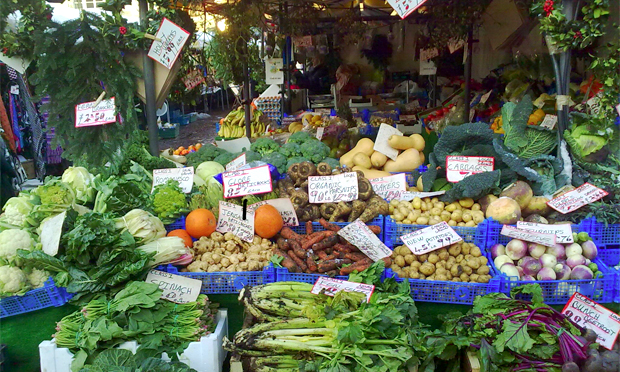
A typical greengrocer’s table, resplendent with cabbage and spinach. Photograph: Sean Hickin via Flickr
Anxious mother pleads with truculent daughter: ‘It’s broccoli darling.’
‘I say it’s spinach, and I say the hell with it!’
The famous New Yorker cartoon of 1928 was an understandably sceptical response to the Popeye spinach myth: ‘Strong to the finish, ‘cause I eats me spinach’. Myths about the iron and vitamin A content of this delicious but often misused leafy vegetable were debunked, un-debunked and re-debunked, for decades.
But the dialogue tells us all we need to know about small children and vegetables. And of course all our sympathies are with the child.
The sensitive palates of the very young react unfavourably to the rank smell and unpleasant texture of badly cooked veg. (A special hatred of Brussels sprouts has dwelt within me from an early age.)
There is something about the brassica family that lends itself to unpleasant odours coming from overcooked members of the tribe. Jay Rayner writes of idyllic childhood holidays that were perfumed with the “honk of old boiled vegetables” in a genteel seaside town.
The longer you boiled them the worse the smell, a sulphurous miasma telling of the tragic loss of flavour, nutrients and antioxidants, as the cooking water was drained away, and the acrid sodden remains were dished up, usually in a tasteless white sauce. That was then.
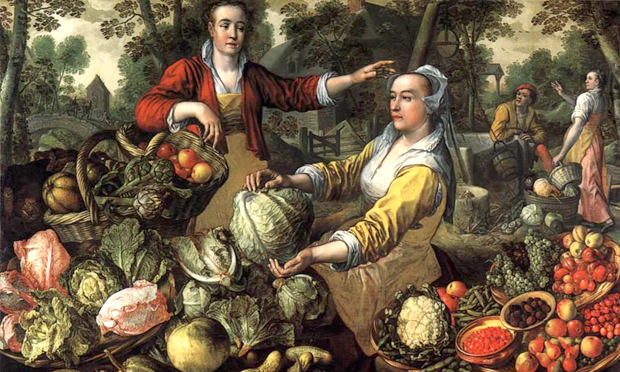
Detail from Joachim Beuckelaer’s Earth, one of his series depicting The Four Elements. Image: Wikimedia Commons
Local
Now we all know to cook the freshest cabbage, washed and sliced or coarsely chopped, in a very little water until just soft, by which time the water has evaporated, then enhanced with tossed in butter and garlic, or olive oil and spices, and eaten hot.
A recipe from ancient Rome, interpreted by Sally Grainger, who has the unique virtue of being both a professional chef and a distinguished classicist, suggests cooking the washed and drained chopped cabbage in a little olive oil in a covered pan until just soft, then stirring in a little sweet white wine and ground cumin, dressing it with fish sauce (nam pla) and serving with steamed finely sliced leeks, chopped fresh coriander and black pepper.
But long slow cooking, when well handled, can avoid all the misery and woe, and create a cabbage stew of intense flavours and mellow richness, like the French garbure from the Pyrenees, peasant food that would look after itself for hours on end, in which root vegetables, onion and cabbage are cooked together, along with dried beans and either basic cheap cuts like bacon and pig’s trotters, sausages and ham bones, flavoured with herbs and peppercorns – or a more posh version with confit duck or goose, and a chunk of local ham.
Choucroute garnie, from Alsace, is also cooked long and slow, the main ingredient being sauerkraut, fermented cabbage, with a heavy load of salted, smoked and fresh meats and sausages, cheered up with garlic, herbs and spices.
Fermented cabbage is a vital source of nourishment and vitamins. We can get it here in Hackney, as kimchi or sauerkraut. Many of our Farmers Markets sell home-made sauerkraut, from local producers, and it’s more versatile than the classic choucroute would let you think. You can add it to stews and soup and salad.
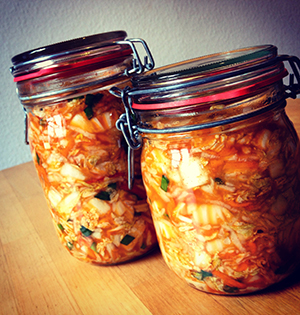
Kimchi. Photograph: Marcus Buchwald via Flickr
But kimchi is more subtle, more versatile. In Korea (where there are over 200 varieties) fermentation is considered the best way to preserve foods over the winter, and kimchi is an essential part of every meal. Oriental stores and supermarkets in Hackney sell various brands.
Way back in the early seventeenth century salads were a new trend, but cabbage was seen as peasant food. Giacomo Castelvetro, travelling with friends in France in winter, stopped at a prosperous looking inn where they hoped the kitchen garden would provide a salad, but there was nothing in it but cabbages. A smart young woman shredded one of them finely with a sharp knife and dressed it with salt, oil and vinegar, a pleasant surprise to them all, and an object lesson to the English, who Castelvetro was trying to persuade not to eat so much meat and sweet things.
He fled to England from the Inquisition, and might well have explored the market gardens of Hackney, when he was living in the City of London, remembering cabbages piled up on market stalls of the Low Countries, like the detail above this section, taken from a painting by Joachim Beuckelaer.
There is more to raw cabbage than commercial coleslaw, a sad mixture of anonymous veg and synthetic gloop. It is salutary to compare Monty’s (in Hoxton Street) crisp, in-house slaw, with its creamy slightly mustardy dressing to the more expensive supermarket stuff. (This column can hardly be accused of high-minded neutrality, being an old friend of Monty’s mum).
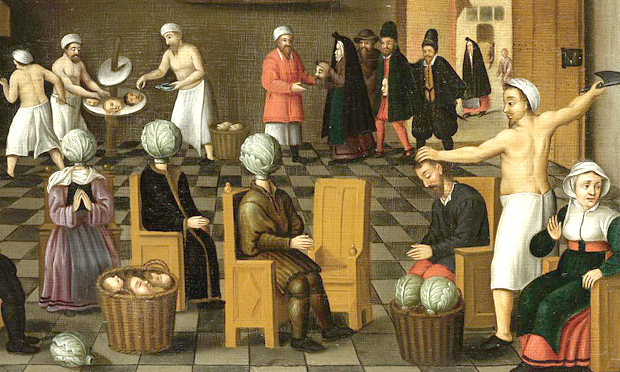
Detail from The Legend of the Baker of Eeklo by Cornelis van Dalem and Jan van Wechelin. Image: Wikimedia Commons
The curative powers of cabbage
According to legend, when the citizens of Eeklo in Flanders felt funny in the head they went to the baker, and he put them right in quite an unusual way.
He must have been an instinctive healer, who understood how sitting comfortably, in the warmth and fragrance of his bakery while he sorted out their poor troubled minds, was a solace to depressed or anguished souls.
As you can see above, the artists Cornelis van Dalem and Jan van Wechelin pictured his method in a brutally realistic way – the heads of the afflicted were chopped off, massaged in soothing ointment and baked in the oven, replaced temporarily with cabbages.
This transformation from psychosis to a temporary vegetative state, then back to normality, might have been achieved with drugs, but the soothing comfort and kindness of the baker surely played the greater part.
Perhaps Hackney’s many artisan bakers have the same effect, when we crowd in for our coffees and buns, with traffic jams of buggies and cross old ladies trying to just pay for a small wholemeal, cabbage heads are needed.
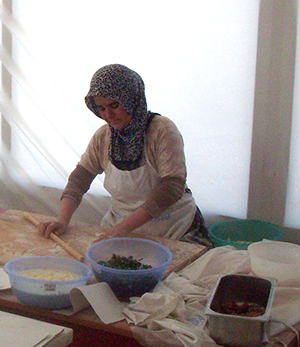
A Turkish woman prepares gozleme. Photograph: CookingwithLittleBuddy.com
We end where we began, with spinach, as our ever hopeful legionary trudges yet again up Stamford Hill, stopping off at one of the many Turkish bakeries to grab a handful of gozleme made by the heroines of this column, the grannies, who roll out balls of dough to a floppy round shape, toss it onto the convex metal dome to cook briefly, flip it over, then take it off, and lay on half of one side a generous amount of raw chopped spinach, seasoned with feta cheese, salt and pepper, fold it over, and plonk again on the heat so that the spinach cooks in its own vapours, perfuming the bread with the fresh aromas of the filling.
No pong, much joy. Definitely not broccoli.
